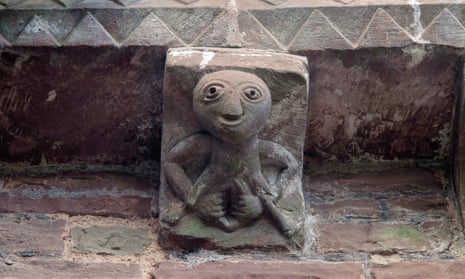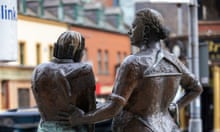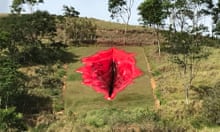Carved into stone, these women squat, naked, sometimes cackling, pulling open their enlarged labia: it’s no wonder Victorian clergymen attempted to destroy or hide the glorious, mysterious figures known as sheela na gigs.
The carvings are found on medieval churches, castles and even gateposts in Ireland, the UK and much of mainland Europe. They seem to have their origins in the 11th century; the oldest discovered in the British Isles so far dates back to the 12th century, the youngest to the 16th. Yet their beginnings are an enigma. Early theories from art historians claimed they were grotesque hag figures to warn against the sins of lust – a way of keeping the minds of churchgoers and monks pure. Others suggest they are a talisman against evil: the act of women flashing their genitals has been believed to scare off demons as far back as the ancient Greeks. More recently, researchers have leaned towards the idea that the sheela is a pre-Christian folk goddess and her exaggerated vulva a sign of life-giving powers and fertility. Even her name is an enigma – although one theory is that “sheela” could mean an old woman or crone, and “gig” was slang for genitals.
If there ever was such a thing as “big dick energy”, the sheela na gig is the embodiment of big vagina energy. She has long fascinated and inspired academics and artists alike – a PJ Harvey song is devoted to her: “You exhibitionist!” Harvey sings on her 1992 single Sheela-Na-Gig; Sarah Lucas has also incorporated them into her work.
And now, the sheela is being given another lease of life. In Dublin this week, new sheelas crafted in clay with 22-carat gold-lustred labia and beautifully glazed vulvas will be covertly placed in sites that are significant to women’s struggle.
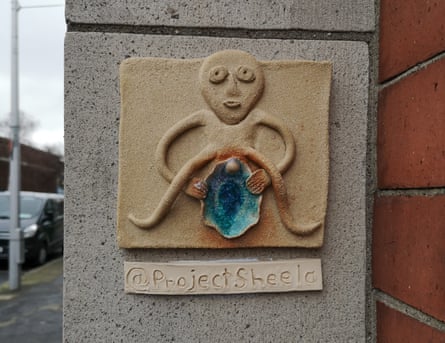
“Irish feminists have reinterpreted the concept of the sheela,” says the ceramicist behind Project Sheela, who has asked to remain anonymous. “Some scholars thought the sheela was an image of evil, or the embodiment of sin, but we see the sexuality of the sheela as positive and empowering,” she says.
The scandal of Irish mother and baby homes, where thousands of unmarried mothers and their young children were subject to horrific cruelty and abuse by a network of institutions run by the state and the Catholic church, is still coming to light - as are the mass graves where neglected babies were buried in secret. Last year, Project Sheela placed one of its sheelas outside one of the former homes – or Magdalene laundries, as they were known – on Sean MacDermott Street in Dublin, the last laundry to close when it shut its doors in 1996.
“We wanted to honour the women who suffered there,” says the project’s spokesperson. “The reason women were sent to these laundries was because of the Catholic church seeing women’s sexuality as dangerous and sinful – the women were punished and abused by the nuns, who believed they were evil.”
The sheela, she says, is an important “symbol against misogyny – one of unapologetic female empowerment and sexuality”. The two artists behind Project Sheela – one a ceramicist, the other a street artist – want the project to “be independent from us as artists”, hence their anonymity. Due to Covid, they have been confined to Dublin, but they want to spread the sheelas to other cities too.
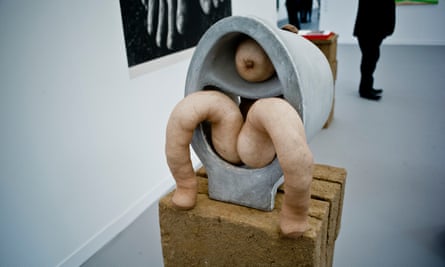
Whatever its origins or meaning, there is something entrancing and alluring about the image of the sheela. Dr Barbara Freitag, a former lecturer in intercultural studies at Dublin City University and author of the 2004 book Sheela Na Gigs: Unravelling an Enigma, was the first to put academic muscle behind the idea of the sheela as a goddess or talisman. She became fascinated by sheelas in the 1980s after reading about a US academic who had been denied access to see some that were “hidden away” in the National Museum of Ireland in Dublin. What could possibly be so frightful, she thought. “And, of course, the prevailing theory at the time was that these were portraying the evil of lust – and that they were put up on churches as warnings – which is absurd.” Why? “Because they’re so high up,” she says. “You’d almost need binoculars to see some of them!”
Freitag travelled widely through England and Ireland and found that “they were obviously figures that had nothing to do with the church originally. They were found predominantly in rural areas, and we have quite a lot of documents showing that people there guarded these sheelas with their lives against the priests, in particular here in Ireland, who were trying to destroy them – and did destroy them. There are various decrees from bishops saying they should be hacked off walls.”
When Freitag visited communities where sheelas were present, “fertility was always the first word that came up”. One of the women she spoke to told her that, at lambing time, farmers still present a ewe to the sheela in the hope that it would lead to a fertile spring. They are rural phenomena, because those people “relied on life-giving powers”.
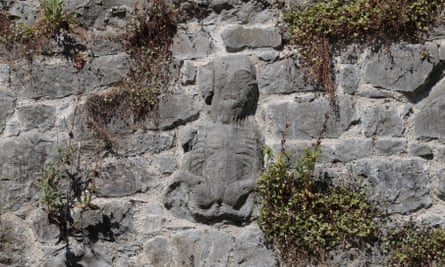
The notion of sympathetic magic – that you can touch an object and receive its power – is key to understanding the sheelas, Freitag believes. “In medieval times, there was such a high maternal mortality rate that you wanted a big vulva to ensure the child came out as quickly as possible, because a long, protracted birth could well mean the death of the child and the mother.”
Medieval childbirth aids “were about making the vulva flabby and big – such as putting butter in the vagina to help the baby slide out quicker,” she says. So it makes sense that the sheelas would act as a talisman to aid childbirth.
Ireland has by far the highest concentration of sheela na gigs, with more than 100 of them, as documented by enthusiast Jack Roberts and his Sheela Na Gig project. But they have also been found as far and wide as England, Wales, Scotland, Italy, France, Spain and Norway.
“There is a great variety in the ways sheelas are presented,” says Prof Georgia Rhoades, who published a paper on sheela na gigs in 2010. “We don’t have to lock them down with just one possible interpretation.”
Rhoades points to the sheelas’ similarities with other figures, such as the ancient Greek goddess Baubo, who was depicted with her vulva showing. “I really hope that people are beginning to see the joy in some of them,” says Rhoades, pointing to several sheelas that clearly look like depictions of masturbation. “There is one in Oaksey in Wiltshire and her vulva is right down to her knees and she’s grinning, like she’s celebrating something – and I like to think she’s celebrating female sexuality. And she’s really the only decoration in the church.”
One thing that most of these figures have in common is that the upper parts of their bodies belong to elderly women. This fascinated Freitag. Why were these figures of fertility also so reminiscent of mortality? “The answer is, of course, because life and death go hand in glove,” she says. In Church Stretton, in Shropshire, a sheela na gig sits above the door that the dead would be brought in and out of. “The ideas of birth and death are essential to thinking about the vulva,” says Rhoades. “To me, the Church Stretton sheela is saying that you come out of the earth, you return to the earth, you come out of me and you return to me … You can ignore death as much as you want to, but death is going to come.
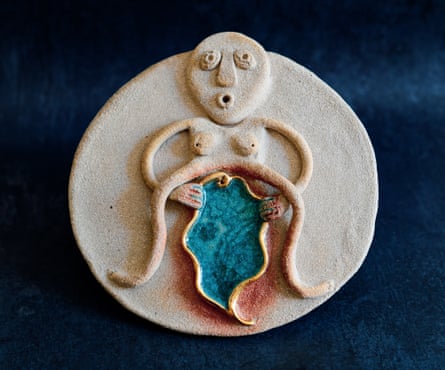
“And that power is even more potent when you think about the sheelas that are occulted, like the one at the Rock of Cashel in Co Tipperary. She is hidden at the top of the castle walls. For someone to create that symbol, and to put it in a place where nobody can see it readily, means there is a real power embedded in that figure.”
Rhoades recalls meeting a young curator from the National Museum in Dublin a few years ago, who had been asked to do an inventory of the sheelas the museum holds (most of which are hidden away, she says). “He said some of his colleagues were very concerned for him – they were worried the sheelas might cause undue arousal in a young man!”
For the women behind Project Sheela, the rediscovery of the history of the sheela is part of a shift in Ireland “towards a more secular society, especially among younger people, who are now looking to choose their own spiritual symbols away from the oppressiveness of the Catholic church”. They point to the growing interest in pagan symbols such as the goddess Brigid, who shares her name with a Catholic saint and whose spring festival, Imbolc, is celebrated more and more by young people, with a petition to make it a national Irish holiday.
It seems that once you see a sheela na gig, it is impossible to let go of it. We may never know the truth about how they came to be, but as Rhoades says, what matters is how they are seen as symbols now: powerful, important, unashamed depictions of female genitalia and inner strength. Freitag, who is now retired, had a long career in academia. “I’ve written two books and almost finished another one since and, really, nothing has touched me as much as the sheela na gigs did all those years ago – because I could sense all the agony and hope that was attached to those figures in medieval times.” Centuries later, this mysterious figure is offering hope still, in all her glory, as a new generation depict her in their own way.
